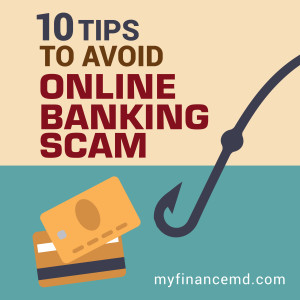 Fidgeting in her laptop, Janet is excited to see how much she was able to save to date. Two weeks from now, it’s Jenny’s 7th birthday, her daughter. She’s been saving 2,000 pesos per payday for eight months now, to be able to save, she stopped eating out with her officemates and resisted stopping by at Starbucks coffee every payday. She usually checks her balance at the ATM but earlier she received an email saying that, she should verify her bank online account. Thinking she might as well try it out and since she is also excited to know how much has she has already saved for the birthday, she clicked on the link provided and answered the questions provided. She noticed that the bank’s website is a little odd, she couldn’t get her balance. So, she logged out again, and she typed the name of the bank’s URL directly to the browser, and finally she was able to see her balance as of the date. “Yes! 50,000 Pesos” she exclaimed. She is pretty proud of herself that she was able save that amount, just enough for Jenny’s birthday party. Her daughter still doesn’t know yet that she will be having a party for her 7th birthday. She decided to tell tomorrow.
Fidgeting in her laptop, Janet is excited to see how much she was able to save to date. Two weeks from now, it’s Jenny’s 7th birthday, her daughter. She’s been saving 2,000 pesos per payday for eight months now, to be able to save, she stopped eating out with her officemates and resisted stopping by at Starbucks coffee every payday. She usually checks her balance at the ATM but earlier she received an email saying that, she should verify her bank online account. Thinking she might as well try it out and since she is also excited to know how much has she has already saved for the birthday, she clicked on the link provided and answered the questions provided. She noticed that the bank’s website is a little odd, she couldn’t get her balance. So, she logged out again, and she typed the name of the bank’s URL directly to the browser, and finally she was able to see her balance as of the date. “Yes! 50,000 Pesos” she exclaimed. She is pretty proud of herself that she was able save that amount, just enough for Jenny’s birthday party. Her daughter still doesn’t know yet that she will be having a party for her 7th birthday. She decided to tell tomorrow.
A day after that, Janet was one of the first people who’s waiting for the mall to open. As the mall opens, she rushed at the nearest ATM. To her surprised, the money in the balance is only 50 pesos. She checked again for three more tries. She checked again using a different machine. Yet still the same. Her heart began to race, she went to the bank asking for an explanation but the bank said. “Mam, you may be a victim of an online scam called Phishing.”
What is Phishing?
Phishing (from Wikipedia) is the attempt to acquire sensitive information such as usernames, passwords, and credit card details (and sometimes, indirectly, money), often for malicious reasons, by masquerading as a trustworthy entity in an electronic communication.
Phishing emails may contain links to websites that would take you to the fake websites. Phishing is usually carried out by email spoofing or text messaging (that contains links) and it often directs users to enter details at a fake website whose look and feel are almost identical to the legitimate ones.
Let me give you an example of a phishing email:
Taken from Wikipedia. This is an example of a phishing email, disguised as an official email from a (fictional) bank. The sender is attempting to trick the recipient into revealing confidential information by “confirming” it on the phisher’s website. Note the misspelling of the words “received and discrepancy.”
Also note that the URL of the bank appears to be legitimate, the hyperlink would actually point to the fake website of the phisher.
Do you want to see some actual Phishing emails?
Try to look at your mails in your SPAM folder. I’m not saying that all of those are from phishers, because, some can also be seen mixed up with regular emails that you received.
Just recently, I heard in the local news, some depositors of one of the big banks in the Philippines lost their money from online banking. Watch here for the news report:
“Ilang depositors nawalan ng pera sa online banking” – ABS CBN TV Patrol
Let me give you some emails which I have in my SPAM folder and would give you a RED FLAG if you also receive this:
- URGENT MESSAGE
Title of Email: “Urgent: About your Paycheck, USSA Bank”
Body of Email: Hi Pinky Intal,
Please verify your details to accept payment:
It has link> ussabanks.com/payments
Questions to ask yourself?
I am not in US, there is no branch of USSA bank here in the Philippines. Why are they sending this to me? (Red flag)
- YOU WIN SOMETHING, OR DID YOU RECEIVE YOUR MONEY?
Title of Email: Did you receive your deposit?
Body of Email: This is a courtesy email from Click Clone C.ash Money System, to confirm you received our recent deposit in the amount of $ 4,293.29
Click Here. <Link>
Questions to ask yourself?
I don’t know any Click Clone money system. But for those people who knew that, they will think it is legitimate. But if you look at the spelling, they misspelled it. Cash to C.ash. (Red Flag)
- From PayPal
Title: of Email: You received a payment from PayPal
Body of the Email: You have received a new payment. Please claim it right now:
<link: Paypal.com.Notification>
This page won’t be up much longer, so please, get your payment now.
I will be waiting for you.
-Paypal
Questions to ask yourself: Now, if you use Paypal like me, you may fall into this trap. Most especially if you are too excited to get your new payment. To verify, don’t click on the link provided. Type the Paypal’s URL, if there is really a payment, you can see it in your legitimate Paypal account. If there is none, then, that is a Phishing email.
Those above examples are actual emails I received just this month. There are many more emails just like that. They are becoming more creative in doing this. So the public should always be aware.
10 Tips to Prevent on becoming the Next Victim of Phishing:
- Pick up the phone to verify if there is such a thing like a withdrawal, deposit or winnings in your account. Call the legitimate phone numbers of the bank. Not the one sent by a text message or email.
- Do your own typing. Instead of clicking the link provided. Never go to your bank’s website by clicking on the links included in the email. Type the URL of the bank involved.
- Enhance your Security. Use security software (anti-virus, anti-spam, spyware).
- Don’t save your passwords on the internet or even on your phone. Do not use the “remember the password” if your phone or laptop gets stolen, they can use it. Once your gadgets or laptops gets stolen, notify the network immediately and also change all the passwords of your social media (Facebook.. etc…), emails and even your passwords from your existing, online banking apps in your phone.
- Don’t do financial transactions in public internet shops. They can capture your account details and passwords.
- Read your statements in your credit cards. Check if all the transactions that are there are true. Make sure that they also have the current contact information for you. Including your mailing address and email address.
- Learn to identify suspected Phishing Emails.
- Do not give any personal and important account information or credit card details from anyone even coming from an email or text message from a friend. You do not know if your friends’ email has just been hacked or his cellphone has been stolen and been sending those emails and text messages to all his contact list.
- If you have the slightest doubt, hold off. Do not risk it.
- Check back frequently to read about new scam or fraud that is evolving today. You can always read our blog, I will keep you up to date. You can subscribe here for free.
After that fateful day, although heartbreaking, Janet sadly called the suppliers to cancel her orders. First, the venue, the birthday cake, the clown and also all her friends and relative that she already invited. She was debating in her head, will she tell her? How could she tell Jenny? She doesn’t have the heart to tell Jenny, that there will be no birthday party.
Always stay alert,
Read More:
- Investment Scams: How Not to be a Victim?
- Saving Millions in Bank, How Safe it is?
- Hurdles of Financial Freedom (Mga Balakid sa Iyong Pag-Yaman!)
- The Top 10 Life Insurance Companies in the Philippines The Most Updated and Most Unbiased Review 2014
- 10 Signs You Are A Money Smart Mom
If you have questions: contact me here.
Source/s: Wikipedia, ABS-CBN News.
Latest posts by Pinky De Leon-Intal, MD, RFC (see all)
- Say Goodbye to Chronic Lifestyle Diseases (Hypertension, Diabetes, Cancer, Gout, etc.) with Right Food and Right Water - 23 May, 2023
- Embracing Superpowers: A Mom’s Journey as a Doctor, Professor, and Financial Consultant - 19 May, 2023
- Celebrating the Power of Women: Honored by Philippine Daily Inquirer - 17 May, 2023




[…] 10 Tips to Avoid Online Banking Scam […]